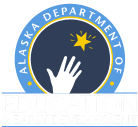- Cama-i, quyana tailuci!
- (Central Yup’ik)
- "Greetings, thank you for coming!"
Instruction and Intervention
Vision
Beginning in infancy, children have many opportunities to interact with adults and other children in ways that build their oral language skills. Children also have many opportunities to playfully explore and learn from their surroundings. As they get older, they are exposed to written language in many forms, and adults in many settings provide children with opportunities to play with oral and written language. In the blueprint, adults are identified as parents, caregivers, extended family, teachers, or anyone acting as a teacher. As children move into school, they receive explicit and systematic instruction in reading, writing, listening, and speaking skills. If children struggle with the development of skills, they receive interventions that directly address their needs. Instruction is designed to be engaging and to respect the students’ cultures and interests. To that end, adults provide culturally relevant opportunities for children to write, discuss, and speak for a variety of purposes in the learning environment.
Quick View of Instruction and Intervention
Adults (identified as parents, caregivers, extended family, teachers, or anyone acting as a teacher) provide instruction and opportunities for learning for young people as is age and skill appropriate.
The content of this instruction addresses the following areas:
- Oral language & vocabulary
- Print awareness
- Phonological awareness
- Letter knowledge & phonics
- Fluency
- Comprehension
- Writing
- Disciplinary literacy
Within the blueprint, the delivery of instruction takes the following forms and characterizations:
- Designated literacy instruction time
- Explicit and systematic instruction in reading and writing
- Modeling and scaffolding of instruction
- Intentional differentiation and grouping
- Student participation, motivation, and engagement
- Meaningful selection of instruction materials
- Use of technology
- Incorporation of the student’s primary language other than English
The blueprint provides for interventions, as necessary, in the following areas:
- Language development
- Reading
- Writing
